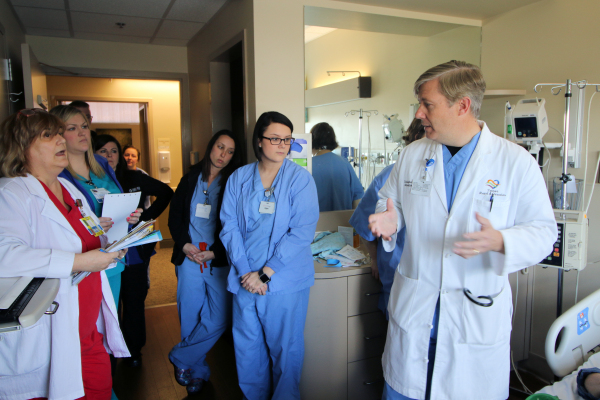When someone is having a heart attack, every minute that passes can result in more damage to his or her heart. But quick assessment and treatment can give cardiologists the best chance of saving a patient’s heart muscle.
That’s why medical teams at Tanner Health System are holding trainings called ST-Elevation Myocardial Infarction (STEMI) drills to improve response times for patients experiencing a life-threatening heart attack.
 STEMI drills are planned training scenarios where a mock patient comes into the hospital presenting signs of an acute heart attack. Recently, Tanner Medical Center/Carrollton’s 4 East nurses and patient care team participated in the fast-paced, hands-on training.
STEMI drills are planned training scenarios where a mock patient comes into the hospital presenting signs of an acute heart attack. Recently, Tanner Medical Center/Carrollton’s 4 East nurses and patient care team participated in the fast-paced, hands-on training.
These drills are keeping Tanner’s medical teams on their toes, helping them remain sharp and ready to respond at a moment’s notice.
“We started doing STEMI drills when we were getting our certification for percutaneous coronary intervention (PCI),” said Jennifer Smith, RN, PCCN, nurse manager for 4 East and the infusion center at Tanner Medical Center/Carrollton.
“These drills serve as a continuing education for our nurses where we provide hands-on training to quickly identify and respond to patients who are having a heart attack. Heart attacks may happen more often in the ED, ICU or CPCU, but all of our medical teams need to be prepared. These drills help us to stay in practice.”
In a heart attack, arteries to the heart become blocked and blood flow in that artery slows or stops. To reopen the blocked artery and restore blood flow, interventional cardiologists perform a life-saving, non-surgical procedure in the cath lab called PCI — also known as angioplasty and stenting.
The procedure is key in STEMI drills because once the heart attack diagnosis is made, the sooner the procedure can begin — and the sooner blood flow to the heart can be restored.
The longer it takes to deliver care, the more damaged the heart becomes. That’s why the first 90 minutes after a patient begins showing signs of a heart attack are extremely crucial.
Research shows that when patients suffering major heart attacks undergo angioplasty within 90 minutes of experiencing symptoms, they are much more likely to survive the event and avoid significant damage to their heart.
Ninety minutes is a national standard response time that hospitals have to get a heart attack patient emergency care after they begin showing symptoms of a heart attack and STEMI drills are helping Tanner get its response times down pat.
“We are training to get our time even lower than that national benchmark,” said Smith. “Ninety minutes isn’t really a lot of time. In that timeframe, a lot has to happen to get a patient to the cath lab as quickly as possible.”
First the nursing team has to identify if a patient is presenting signs or symptoms of a heart attack — which, according to Smith, can be a challenge if you aren’t sure of what to look for.
“We know the classic symptoms of heart attack include tight or crushing chest pain, jaw pain or neck pain, but there are other vague symptoms that can go unnoticed, and not every patient will show the same signs,” said Smith.
She explained that some patients may just have jaw pain, neck pain, back pain or even some combination.
 “Our STEMI drill patient came in with a few vague symptoms: chest and shoulder pain, shortness of breath and some nausea and vomiting,” said Smith. “The patient also told her nurses that she had been tired a lot lately. These symptoms could mean many things, but her vague shoulder and jaw pain were two symptoms that could signify that she was having a heart attack. Our team did an excellent job quickly recognizing that those symptoms were signs of a possible heart attack. They did what they were trained to do. They followed procedure and began treatment right away.”
“Our STEMI drill patient came in with a few vague symptoms: chest and shoulder pain, shortness of breath and some nausea and vomiting,” said Smith. “The patient also told her nurses that she had been tired a lot lately. These symptoms could mean many things, but her vague shoulder and jaw pain were two symptoms that could signify that she was having a heart attack. Our team did an excellent job quickly recognizing that those symptoms were signs of a possible heart attack. They did what they were trained to do. They followed procedure and began treatment right away.”
After the nursing team identifies the patient’s symptoms, they order an EKG. An EKG confirms changes in heart rhythm that may further indicate that the patient is having a heart attack.
Once the EKG is complete, the team notifies the cardiologist and he or she confirms the patient’s EKG readings and will call a heart alert to their medical team. The heart alert goes out through a pager system to notify the medical team that there’s a heart attack patient who needs to get to the cath lab immediately.
While the doctor and nurses are in the patient’s room administering heart-saving medications and preparing the patient to be transported to the cath lab, the cath lab team is preparing to receive the patient for PCI.
“Time is critical in heart attacks,” said Christopher Arant, MD, a board-certified interventional cardiologist at Tanner Heart & Vascular Specialists. “The longer it takes for a patient to receive treatment, the greater chance of irreversible heart damage or death. That’s why we say time is heart muscle. This training is going to help us save more hearts.”
More information about PCI and Tanner’s other cardiac services is available online at www.TannerHeartCare.org.